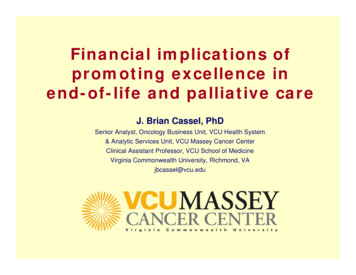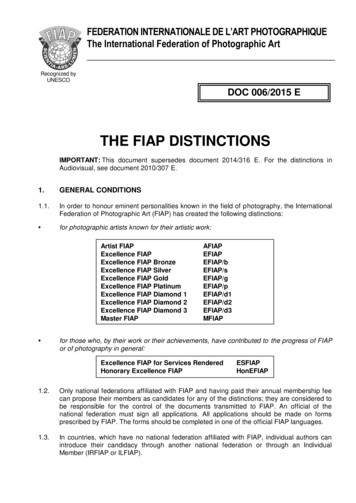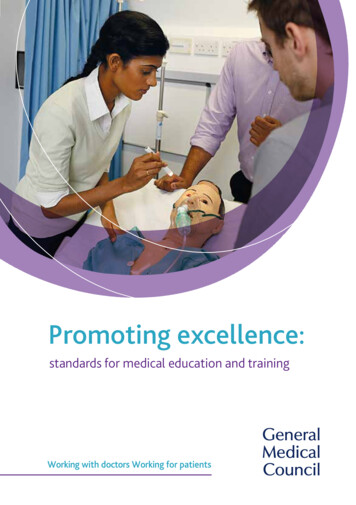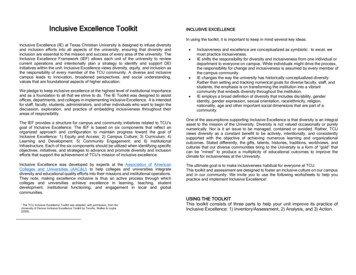
Transcription
Financial implications ofpromoting excellence inend-of-life and palliative careJ. Brian Cassel, PhDSenior Analyst, Oncology Business Unit, VCU Health System& Analytic Services Unit, VCU Massey Cancer CenterClinical Assistant Professor, VCU School of MedicineVirginia Commonwealth University, Richmond, VAjbcassel@vcu.edu
Current state of US health careHealth care for patients with advanced illness is marked by:– Fragmented multi-specialty care; no one in charge.– Lack of training on needs of seriously ill, including symptoms,communication, coordinated transitions.– Lack of communication.– Misalignment MD / hospital / payor incentives for controllingresource utilization for EOL patients.Dartmouth Atlas Project report on cancer care finds“ remarkable variation depending on where the patients live andreceive care. Even among the nation’s leading medical centers, thereis no consistent pattern of care or evidence that treatment patternsfollow patient preferences. Rather, the report demonstrates that manyhospitals and physicians aggressively treat patients with curativeattempts they may not want, at the expense of improving the qualityof their last weeks and reports/Cancer report 11 16 10.pdfSlide 2
Clinical care challenges for seriously illhospitalized patients35 AMCs reviewed charts of 1,596 patients with high mortality DRGs (HIV, Ca, Resp,or HF) and 2 prior admits. Most did not receive palliative care.Twaddle, Maxwell, Cassel et al., (2007). Palliative care benchmarks from academic medical centers.Journal of Palliative Medicine 10 (1): 86-98.Slide 3
Palliative Care Inter-professional teams – MDs, Nurses,pharmacists, social workers, chaplains, and others Provide expert relief of pain and suffering Help clarify prognosis and set care goals Patient-centered; involve and support family Focus on complex and advanced illnesses May bridge the gap between “curative” and “endof life” care CMS, ABIM, ACGME recognized In 63% of hospitals with 50 beds, and 85% ofhospitals with 300 beds– See http://www.capc.org/reportcard/findingsSlide 4
Virginia Commonwealth: A pioneerprogram continues to grow2011PC Usual, expected care1999Cancer pain consultsby APNPC Not usual care2 APN, 1 MD shared FTEChaplainMSW sharedVolunteers11-bed PC Unit with expert nursesPC Fellows x 3500 PC Unit admits1400 inpatient consults300 Outpatient clinic / consultsRequired IM residency trainingRotating fellows HO, SO, RO, GYN,Peds ONC, Med Psych, Geriatrics RN trainingSlide 5
Impact of Palliative Care A 41 y/o woman with Stage IV breast cancer seen in ED forsevere dyspnea from lung metastases. She was seen by PC,improved with nebulized fentanyl, and admitted to the PCU foraggressive dyspnea management. The alternative underconsideration was intubation and ICU admission. She improvedand was discharged home with hospice. 67 y/o man with Stage IV, extensive lung cancer; debilitated,septic and having trouble breathing, admitted to ED. Seen by PCas well as ICU team. Admitted to ICU but after 2 days of ICU care,family asked for PC consultants to return; they had thought aboutwhat was offered and wanted to transfer the patient out of ICU toPC unit for continued life support, but outside of an ICU. Temel (MGH) study: Integrating PC from diagnosis forwardimproves quality of life; lowers depression; increases survival by2 months in patients with advanced lung cancer.JB Cassel & LJ Lyckholm (2007). Rethinking our M.O. Journal of Palliative Medicine 10 (3), 649-650.LJ Lyckholm, JB Cassel, S Hickey (2007). Palliative Care Consultation in the Emergency Department. AAHPM. Salt Lake City, UT.JS Temel et al (2010). Early Palliative Care for Patients with Metastatic Non–Small-Cell Lung Cancer. N Engl J Med 2010;363:733-42.Slide 6
3SymptomsReduced ByPalliativeCareSpecialistsPainNauseaESAS 0-32.5Depression2Anxious1.5Shortness of Breath1Drowsy0.5Appetite01st dayComparison DayFatigue/ActivityPalliative Care patients' symptom assessments 2010n 35Time1Time2# with no signif symptoms017# with 1 signif symptom66# with 2 signif symptoms52# with 3 signif symptoms96# with 4 signif symptoms154Khatcheressian, Cassel, Lyckholm, Coyne &Smith. Oncology, September 2005Slide 7
Palliative Care Quality CarePalliative care is quality care as defined by theNational Quality Forum and the Institute forHealthcare Improvement:¾ Patient-centered¾ Beneficial¾ Timely¾ Safe¾ Equitable¾ EfficientSlide 8
Are clinical benefits sufficient to motivatehospitals to invest in palliative care?What else do hospital administrators want, thatPalliative Care can help produce?–––––Patient and family satisfactionReferring provider satisfactionCost reduction when payment is flat / fixedIncreased flow/access especially in ICUsLower hospital mortality and re-admission ratesPalliative care programs assist with all of these kinds ofoutcomesSlide 9
PC outcomesPalliative care elements:- Patient-centered, family-oriented- Advanced symptom management- Excellence in communicationPrimary impact is on patientA.relief of pain and other symptomsB.clarification of prognosis and goals of careC.may result in changes to kind of care providedSecondary impact: if A-C achievedD.family – less confused, more satisfiedE.nurses, doctors – appreciate specialist helpF.ICU utilization – some pts shift to acute m/sG.costs – reduced if care is more PC-specificH.revenue – reduced if PC reduces procedures oradmissionsTertiary impact: if D-H achievedI.more access to ICU, less hospital “diversion”J.improve nurse, MD satisfaction, less burnoutK.awards, hospital reputation improvesL.volunteering, donations increaseM.culture of care changes in hospital, communityN.better for payors, societyCassel & Kerr (2007). “Measuring the impact of palliative care:Hospital, patient, and provider perspectives”. U Illinois - Chicago.Slide 10
Hospital contextMetricAdultadmissionsending indeathAdultsurvivors withhigh risk ofmortality *7851,955# AdmissionsAll otheradultsurvivorsTotal adultadmissions23,94926,689% Admissions3%7%90%100%% Inpt Days5%19%75%100%% ICU Days19%44%37%100%9%23%69%100%% Direct costsAvg LOSAvg LOS in ICUCMI (avg DRG irect cost / day 3,006 2,136 1,643 1,810Direct cost / admission 32,043 33,143 8,168 10,699Medicare %51%54%30%# admits with Palliative Care **352441909% admits with Pallative Care45%23%4%6%Distribution of Palliative Care21%26%53%100%From VCU Health System, FY2010, n 26,689 adult admissions* defined as discharge to hospice, or (APR‐DRG ROM subscore of 4 and an SOI subscore of 3 or 4)** Palliative Care Consultation, or Palliative Care Unit, during this hospitalization33%1,702Slide 11
Typical PC Cost Reduction Outcomes 3,500Cases centered ontransfer dayICU to PCU (n 120)Mostly ICU to PCU (n 157) 3,000Some ICU to PCU (n 63)Acute to PCU (n 195)Mean Direct Cost Per Day 2,500 2,000 1,599 1,500 1,230 1,000 879 683 500 -14 -13 -12 -11 -10-9-8-7-6-5-4-3-2-1123456day of stay in relation to day transferred to PCU (1)KR White, KG Stover, JB Cassel, TJ Smith. (2006). Non-Clinical Outcomes of Hospital-Based Palliative Care. Journal ofHealthcare Management 51 (4), 253-267.12Slide 12
8 Hospital study of cost reductionMorrison, Penrod, Cassel et al. (2008). Cost savings associated with US hospital palliative care consultation programs.Archives of Internal Medicine 168 (16), 1783-1790.Slide 13
8 Hospital Study of Cost ReductionDirect costper daySurvivorsDecedents48 hoursbefore PC 843 1,16348 hoursafter PC 605 589 238(28%) 574(49%)DifferenceMorrison, Penrod, Cassel et al. (2008). Cost savings associated with US hospital palliative care consultation programs.Archives of Internal Medicine 168 (16), 1783-1790.Average 406Slide 14
8 Hospital Study of Cost Reduction2000Direct Cost ( )1750Usual Care150012501000750PC consultday 10-11500PC consultday 12-13250123456789 10 11 12 13 14 15 16 17 18 19 20 21Day of AdmissionMorrison, Penrod, Cassel et al. (2008). Cost savings associated with US hospital palliative care consultation programs.Archives of Internal Medicine 168 (16), 1783-1790.Slide 15
Palliative care on day 8 of a 12-dayhospitalization: whose costs are reduced? Most palliative care patients fall under per-casepayment structures– 69% Medicare, 11% Medicaid, 20% other (Morrison 2008)– In most Medicare, Medicaid, TriCare, and uninsured /indigent cases, payment to hospitals is “flat” per case –regardless of LOS or cost– Medicaid: 35 states pay via per-case basis similar to DRGs,and 9 states pay per-diem Thus hospitals’ cost reduction usually helps thehospitals’ bottom line, because payments are flat But, payors do not usually see a reduction inexpenditures from this late-in-stay intervention Exception: when later procedures are avoidedSlide 16
What about movingPC intervention to day 1? Some are trying to move palliative careintervention earlier in the admission, evenin the Emergency Dept. Since this can dramatically alter theintensity of the admission and avoid someprocedures entirely, DRG assignment andreimbursement may be much different. Appropriate measure is net margin: totalreimbursement minus total costs.– Kerr Cassel & Pantilat, AAHPM, 2011.Slide 17
Early contact reduces cost more than revenueFinancial Performance, Palliative Patients, FY03-Q1FY07 20,000 18,000Transfer 16,000 14,000Direct AdmitLoss 12,000 10,000 8,000 6,000Profit 4,000 2,000Total CostData from Mt Carmel health system, Columbus FY2004FY2003 0Expected PaymentSlide 18
Future evolution of palliative care will bedriven both by hospitals and payors Integration of ambulatory PC with diseasefocused care (e.g., cancer, CHF, COPD) Rabow 2003 Brumley 2003, 2007 Temel 2010 – NEJM paper on PC integrated withcancer care for NSCLC pts Fewer ER visits, fewer hospitalizations Hospitalizations are less intensive & costly Thus payors see impact on expenditures – just asthey do with hospice Hospital administrators will need to see that thisis still a “win” for themSlide 19
Payors increasing theincentives to do this 30-day mortality rates Æ quality 30-day re-admission rates Æ quality andreimbursement Bundled payments “Accountable care” organizations Some hospitals already have reasons:– Tertiary hospitals overly full– End-of-life admissions often cost more thanhospitals receive in reimbursementSlide 20
Medical model continues to evolveCurative / LifeProlonging CareCurative / LifeProlonging BePalliative CareCurative /Life Prolonging CareemavreBeCurative / LifeProlonging CareSlide 21
Palliative Care Increases Qualityand Decreases Costs Reduces pain and symptom burdenHonors patients’ values and choicesIncreases quality of life for patients and familiesMaintains and increases survivalInpatient PC reduces hospital costsHigh-volume ambulatory PC may reduce payor,patient costs Improves the education and training of thecurrent and next generations of healthcareprovidersSlide 22
In collaboration with VCUHS PC program & VCU Massey Cancer Center–––––Dr. Laurie Lyckholm, Palliative Care Medical DirectorPatrick Coyne, MSN, PC Clinical DirectorMary Ann Hager, MSN, Administrator, Oncology Business UnitDr. Gordon Ginder, Director, Massey Cancer CenterLisa Shickle, MS, Analytic Services, Massey Cancer Center Kathleen Kerr & Dr. Steve Pantilat at UCSF Dr. Tom Smith, Johns Hopkins Lynn Spragens, Dr. Dave Weissman, Dr. Diane Meier,Center to Advance Palliative Care (CAPC) Other Palliative Care Leadership hip-initiative/overviewSlide 23
Questions and DiscussionSlide 24
MSW shared. Volunteers. 11-bed PC Unit with expert nurses. PC Fellows x 3. 500 PC Unit admits. 1400 inpatient consults. 300 Outpatient clinic / consults. Required IM residency training. Rotating fellows HO, SO, RO, GYN, Peds ONC, Med Psych, Geriatrics RN training. Virginia Commonwealth: A pioneer program continues to grow. 1999. Cancer pain .










